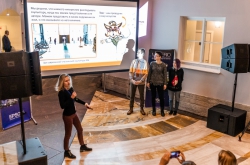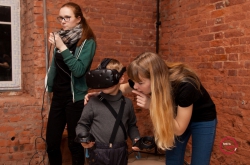You enrolled in a Master’s degree program at ITMO University this year. Is your area of study new to you or are you just improving on what you’re already familiar with?
I graduated with a Bachelor’s degree from St. Petersburg State University last year; my program was called “Applied Computer Science in Arts and Humanities”. We tried our hand at various trades: from programming, 3D modelling, animation and audio- and video-editing to virtual reality. The program is quite unique: it combines computer science, as well as maths and programming, with the use of IT in humanities, art and creative activities.
I decided to continue my studies at ITMO because the program here felt like a logical continuation of my previous studies. My current program is “Multimedia Technologies in Theater, Cinema and Television” program. At the moment, we’re creating digital characters using 3D modelling software; we study subjects related to the development of interactive web applications, animation and multimedia technology.
What was your last major project?

That would be my thesis project; it dealt with augmented-reality multimedia representations of characters for the board game “Imaginarium”. My idea was to create a mobile AR-based application that would serve as an add-on to the original game. I’d chosen several images from the game that contained characters, modeled them in 3D and included them in a final app. As the game asks players to think of the various things that they associate with the pictures they see, I assumed that augmented reality would further stimulate the players’ imagination. The application was developed for Android and is available for download. So far, only several characters have been implemented; when viewed through a smartphone camera, the 2D characters become three-dimensional and can be examined from all angles.
I’ve contacted the game’s publishers and told them about my project; they have expressed interest not only in my AR project, but also in the possibility of 3D-printing the game’s characters. Unfortunately, they haven’t yet devised a way to implement these ideas in a way that wouldn’t take away the players’ attention from the game itself. I think this is an unusual idea even by the game’s standards. It would be great if a whole range of characters could be adapted to AR in this way; such a deck would surely see some interest from board game geeks. This is a very promising form of content representation – it is entertaining and impressive. AR is one of the most promising technologies in the mobile area today – it’s developing rapidly and sees a lot of use in different areas. Just look at Pokémon GO!
I plan to continue my work with AR; in particular, I mean to do my Master’s thesis project on it, but in a less entertaining context.
Have you done any similar projects before that?
Last year, as part of a SPSU student team, I took part in the “Start-Up SPSU2017” competition. We presented a VR-based project and finished in third place having received a grant to bring our project to fruition. The project is an interactive virtual museum of musical instruments called “TimeMelody”. It places users in virtual environments relevant to the eras in which the instruments were common, listen to how they sound and examine their 3D models. The instruments were recorded using a binaural microphone, which made the sounds more realistic and three-dimensional. We created 3D models of some unusual instruments for the projects, including models of the kantele, viola da gamba, lyre, duduk, shofar, and an ancient bone flute; we’d also had some classic instruments, such as the trumpet, trombone, grand piano, flute and others.

What does the future have in store for this project?
We got in touch with a museum in St. Petersburg that can boast a large collection of musical instruments; however, they’ve been wasting away under glass cases for years – they cannot be heard or closely examined. We offered to create an application that would give these instruments a second life, where visitors would be able to hear these instruments, take virtual tours and see these instruments in action in relevant surroundings.
On June 21, we participated in the international conference EVA St. Petersburg at ITMO University. We presented our student projects there – including the AR characters and the virtual museum. We also attended the Big Business Fun Festival (BBFF), and particularly the White Night Startup.
These days, IT is becoming a part of all areas of our life: banking, medicine, urban planning, etc. The Art & Science trend is actively developing – a cluster by that name opened earlier in the year at ITMO. How do you see the future of this field?
I think it is conducive to the development of exciting new cross-disciplinary projects that bring together informational and multimedia technologies. Honestly, I think my study group could easily be a small Art&Technology cluster! We’ve got talented people here, each proficient in a particular technology, with experience in design and creative arts; some of them program or model; some have worked on video-mapping for the Anikushin Workshop during this year’s Night of Museums.

We all constantly work together and help each other learn new things, exchange knowledge and experience – a team like this can do more than one awesome project combining art and technology.
Which projects inspire you, personally? Who do you look up to?
Most of all I’m interested in 3D modelling and all that has to do with it. I find a great deal of inspiring projects on Behance and Artstation, where creative people from all over the world show off their work. With a lot of professional artists, illustrators, designers and painters, the uniqueness, boldness and the scale of their works is impressive and is a source of motivation.

You were recently announced as the winner of the competition for the creation of a pre-stamped postcard commemorating the XIX World Festival of Youth and Students. How did you prepare for the competition?
I signed up for the festival back in winter when it was first announced. In May, the competition was announced for commemorative postal objects in three categories: Postage stamps, envelopes and postcards.
Of course, I drew mine on the last day; sent it right before the deadline. It was meticulous work – the image is made up of many elements. What inspired me to do it? I just thought – why not? Why not try making a contribution, even a small one, into the cultural and historic legacy of an international festival. I’d never taken part in a competition like this, and new experience can be useful. My drawing won, meaning that it will soon be printed on pre-stamped postcards.

You have quite a track record of victories at various competitions. Where and how can one find opportunities for self-development these days?
To be frank, I’ve been quite passive as a student for some time, too; my schedule was packed enough as it is. Then I learned about the various educational youth forums, such as Tavrida, from my more active friends. There, I attended a creative session for artists, sculptors and art experts. It was a bit strange being surrounded by creative youth from all over Russia, but it is something I’ll remember my whole life. Perhaps this gave me the push I needed to develop creatively. Then, I started to attend all these forums and competitions, and meeting interesting people from all over.
There are a great number of communities online where you can find useful information related to learning and self-development, as well as competitions. ITMO University also has great opportunities for startups.

Sometimes people are just not confident enough in themselves or their abilities. Or, for that matter, lazy. Is it worth it to try to take part? How do you motivate yourself not to do nothing?
In this case, the best help can come from friends or from understanding that student life is short and it’s easy to miss out on the chance to express yourself. It takes nothing to submit an application, after all. Once you do that, it gets simpler – you’ll be interested in getting involved. Then comes the realization that you could really win or learn something new just by taking part.
I think the biggest motivation here is the fear of wasting time, which runs out fast. You can study as long as you like, but good opportunities, achievements, new friends and contacts – those are easy to miss out on!





